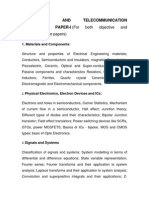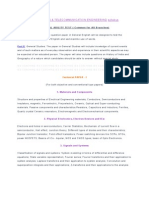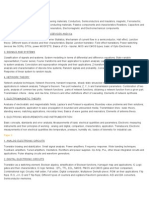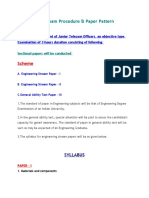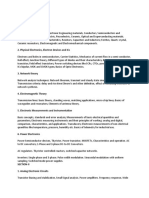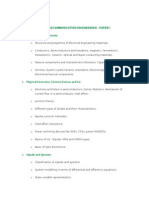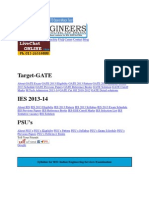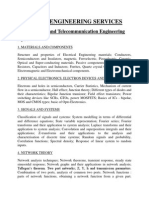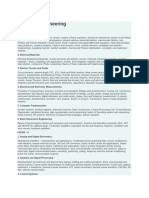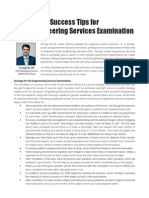(For Both Objective and Conventional Type Papers) 1. Materials and Components
(For Both Objective and Conventional Type Papers) 1. Materials and Components
Uploaded by
mohit4821Copyright:
Available Formats
(For Both Objective and Conventional Type Papers) 1. Materials and Components
(For Both Objective and Conventional Type Papers) 1. Materials and Components
Uploaded by
mohit4821Original Description:
Original Title
Copyright
Available Formats
Share this document
Did you find this document useful?
Is this content inappropriate?
Copyright:
Available Formats
(For Both Objective and Conventional Type Papers) 1. Materials and Components
(For Both Objective and Conventional Type Papers) 1. Materials and Components
Uploaded by
mohit4821Copyright:
Available Formats
(For both objective and conventional type papers) 1.
Materials and Components : Structure and properties of Electrical Engineering materials; Conductors, Semiconductors and Insulators, magnetic, Ferroelectric, Piezoelectric, Ceramic, Optical and Super-conducting materials. Passive components and characteristics Resistors, Capacitors and Inductors; Ferrites, Quartz crystal Ceramic resonators, Electromagnetic and Electromechanical components. 2. Physical Electronics, Electron Devices and ICs: Electrons and holes in semiconductors, Carrier Statistics, Mechanism of current flow in a semiconductor, Hall effect; Junction theory; Different types of diodes and their characteristics; Bipolar Junction transistor; Field effect transistors; Power switching devices like SCRs, GTOs, power MOSFETS; Basics of ICs - bipolar, MOS and CMOS types; basic of Opto Electronics. 3. Signals and Systems Classification of signals and systems: System modelling in terms of differential and difference equations; State variable representation; Fourier series; Fourier transforms and their application to system analysis; Laplace transforms and their application to system analysis; Convolution and superposition integrals and their applications; Z-transforms and their applications to the analysis and characterisation of discrete time systems; Random signals and probability, Correlation functions; Spectral density; Response of linear system to random inputs. 4. Network theory Network analysis techniques; Network theorems, transient response, steady state sinusoidal response; Network graphs and their applications in network analysis; Tellegens theorem. Two port networks; Z, Y, h and transmission parameters. Combination of two ports, analysis of common two ports. Network functions : parts of network functions, obtaining a network function from a given part. Transmission criteria : delay and rise time, Elmores and other definitions effect of cascading. Elements of network synthesis. 5. Electromagnetic Theory Analysis of electrostatic and magnetostatic fields; Laplaces and Poissons equations; Boundary value problems and their solutions; Maxwells equations; application to wave propagation in bounded and unbounded media; Transmission lines : basic theory, standing
waves, matching applications, microstrip lines; Basics of wave guides and resonators; Elements of antenna theory. 6. Electronic Measurements and instrumentation Basic concepts, standards and error analysis; Measurements of basic electrical quantities and parameters; Electronic measuring instruments and their principles of working : analog and digital, comparison, characteristics, application. Transducers; Electronic measurements of non electrical quantities like temperature, pressure, humidity etc; basics of telemetry for industrial use.
(For both objective and conventional type papers) 1. Analog Electronic Circuits : Transistor biasing and stabilization. Small signal analysis. Power amplifiers. Frequency response. Wide banding techniques. Feedback amplifiers. Tuned amplifiers. Oscillators. Rectifiers and power supplies. Op Amp, PLL, other linear integrated circuits and applications. Pulse shaping circuits and waveform generators. 2. Digital Electronic Circuits : Transistor as a switching element; Boolean algebra, simplification of Boolean functions, Karnaguh map and applications; IC Logic gates and their characteristics; IC logic families : DTL, TTL, ECL, NMOS, PMOS and CMOS gates and their comparison; Combinational logic Circuits; Half adder, Full adder; Digital comparator; Multiplexer Demulti-plexer; ROM an their applications. Flip flops. R-S, J-K, D and T flip-flops; Different types of counters and registers Waveform generators. A/D and D/A converters. Semiconductor memories. 3. Control Systems : Transient and steady state response of control systems; Effect of feedback on stability and sensitivity; Root locus techniques; Frequency response analysis. Concepts of gain and phase margins: Constant-M and Constant-N Nichols Chart; Approximation of transient response from Constant-N Nichols Chart; Approximation of transient response from closed loop frequency response; Design of Control Systems, Compensators; Industrial controllers. 4. Communication Systems : Basic information theory; Modulation and detection in analogue and digital systems; Sampling and data reconstructions; Quantization &
coding; Time division and frequency division multiplexing; Equalization; Optical Communication : in free space & fiber optic; Propagation of signals at HF, VHF, UHF and microwave frequency; Satellite Communication. 5. Microwave Engineering : Microwave Tubes and solid state devices, Microwave generation and amplifiers, Waveguides and other Microwave Components and Circuits, Microstrip circuits, Microwave Antennas, Microwave Measurements, Masers, lasers; Microwave propagation. Microwave Communication Systems terrestrial and Satellite based. 6. Computer Engineering : Number Systems. Data representation; Programming; Elements of a high level programming language PASCAL/C; Use of basic data structures; Fundamentals of computer architecture; Processor design; Control unit design; Memory organisation, I/o System Organisation. Microprocessors : Architecture and instruction set of Microprocessors 8085 and 8086, Assembly language Programming. Microprocessor Based system design : typical examples. Personal computers and their typical uses.
Electronics Engg.
S.No
1 2
Subject
Optical Fiber Communication Electrical Engg. Material
BookName
Optical Fiber Communication Electrical Engg. Material Senior
Auth
S.P.Seth
Measurement Instrumentation
Electrical & Electronic Measurement A.K.Sahney and and Instrumentation Electronic Instrumentation Networks & Systems H.S.Kalsi
D.Roy Cha Hayt Liao
Network Theory Engineering Circuit Analysis Microwave Devices and Circuits
Microwave Engg.
Microwave Engg. Microwave Engg.
Sanjeev Gu Pozar
6 Computer Engg.
Microprocessor
Architecture,
Programming & Application Computer Organization and
Ramesh S.
Structure Digital Design 7 Digital Electronics Digital Systems Mordern Digital Electronics
Stalling
M.Morris M
Tocci & Wi R.P.Jain
Elements of Engg. Electromagnetics N.N.Rao Elements of Electromagnetics 8 Electro Magnetic Theory Engineering Electromagnetics Antenna & Wave Popagation Control System Engg. 9 Control System Automatic Control System Linear Control System 10 11 12 Monochrome & Colour Satellite Communications Signal & System Monochrome & Colour Satellite Communications Signal & System Communication System An introduction to Analog and W.H.Hayt Sadiku
K.D.Prasad
I.G.Nagrath B.C.Kuo
B.S.Manke R.R.Gulati
Pratt & Bos
Oppenheim
Simon Hay
Digital Communicatio 13 Communication System Communication System : Analog
Simon Hay
and Digital Modern Digital and Analog
Singh & Sa
Communication System Electronic Communication System 14
B.P.Lathi
Kennedyan
Electronic Devices and Circuits & Integrated electronics : Analog and Jacob Analog Electronics-Digital Circuit and system Microelectronic Circuits
Christos C.
Sedra & Sm
Electronic Devices and Circuits OP Amp and linear Integrated
J.B.Gupta Ramakant
Circuit Solid State electronic devices Semiconductor devices
Streetman S.M.Sze
You might also like
- Manual de Partes Caterpillar C 27Document594 pagesManual de Partes Caterpillar C 27LuisPupiales100% (1)
- Linux Essentials Final Comprehensive Exam (Modules 1 - 16) : Manage The System's ResourcesDocument18 pagesLinux Essentials Final Comprehensive Exam (Modules 1 - 16) : Manage The System's ResourcesgurungeNo ratings yet
- Manual Ispring SuiteDocument44 pagesManual Ispring Suitearchemist50% (2)
- IES Syllabus: 1. Materials and ComponentsDocument2 pagesIES Syllabus: 1. Materials and ComponentsKishlay KrNo ratings yet
- For Both Objective and Conventional Type PapersDocument2 pagesFor Both Objective and Conventional Type PapersiisclaxmanNo ratings yet
- Materials and ComponentsDocument3 pagesMaterials and ComponentssarathNo ratings yet
- Es Electronics SyllbDocument3 pagesEs Electronics Syllbabhikr77No ratings yet
- UPSC ESE Electronics & Telecommunication Engineering Syllabus Paper I SyllabusDocument3 pagesUPSC ESE Electronics & Telecommunication Engineering Syllabus Paper I SyllabusnfgbngfbhgdNo ratings yet
- Ies Ec SyllabusDocument2 pagesIes Ec SyllabusPriyaSinghNo ratings yet
- Materials and ComponentsDocument3 pagesMaterials and ComponentsabhiranyuNo ratings yet
- PSU SyllabusDocument3 pagesPSU Syllabusrahaman.besu5321No ratings yet
- IES SyllabusDocument5 pagesIES SyllabusGopi ShrineNo ratings yet
- Ies: Electronics & Telecommunication Engineering Paper - I: 1. Materials and ComponentsDocument5 pagesIes: Electronics & Telecommunication Engineering Paper - I: 1. Materials and ComponentsrkbazadNo ratings yet
- IES E&TC SyllabusDocument3 pagesIES E&TC Syllabusvipin12krishnanNo ratings yet
- (For Both Objective and Conventional Type Papers) : Electronics and Telecommunication Engineering Paper-IDocument5 pages(For Both Objective and Conventional Type Papers) : Electronics and Telecommunication Engineering Paper-IgeombajobsNo ratings yet
- SyllabsDocument2 pagesSyllabsRohit SharmaNo ratings yet
- Part A:: GENERAL ABILITY TEST (Common For All Branches)Document4 pagesPart A:: GENERAL ABILITY TEST (Common For All Branches)Ajay VishwakarmaNo ratings yet
- Paper - I: General Ability TestDocument4 pagesPaper - I: General Ability TestMerril VincentNo ratings yet
- Ies SyllabusDocument3 pagesIes SyllabusAshish MalikNo ratings yet
- Electronics & Telecommunication Engineering Syllabus: GENERAL ABILITY TEST (Common For All Branches)Document3 pagesElectronics & Telecommunication Engineering Syllabus: GENERAL ABILITY TEST (Common For All Branches)pawantwrNo ratings yet
- Electronics & Telecommunication Engineering Paper - IDocument3 pagesElectronics & Telecommunication Engineering Paper - ISaurabh WadhwaNo ratings yet
- Scheme and Syllabus For The Recruitment of Junior Telecom Officers (Telecom)Document8 pagesScheme and Syllabus For The Recruitment of Junior Telecom Officers (Telecom)akshay4849No ratings yet
- RaoufDocument2 pagesRaoufRaouf ValayappuramNo ratings yet
- Materials and Components:: E & T E IDocument2 pagesMaterials and Components:: E & T E IAnonymous p0bBEKNo ratings yet
- Materials and Components:: Ies Syllabus EceDocument2 pagesMaterials and Components:: Ies Syllabus EceRipan DeuriNo ratings yet
- Paper IDocument3 pagesPaper IER Raman Kumar ChaurasiaNo ratings yet
- Electronic and Telecommunications EngineeringDocument3 pagesElectronic and Telecommunications EngineeringmailforpriyanshuNo ratings yet
- What Are The Subjects Which Come in UPSC Engineering Services - Electronics - Communication - ExamDocument2 pagesWhat Are The Subjects Which Come in UPSC Engineering Services - Electronics - Communication - ExamVikas ChandraNo ratings yet
- Junior Telecom Officer (JTO)Document1 pageJunior Telecom Officer (JTO)Siva Kumar AvisNo ratings yet
- Syll Lec Elecroeng 29 09 2014Document2 pagesSyll Lec Elecroeng 29 09 2014Dharmendra MehtaNo ratings yet
- Ies Indian Engineering Services Electronics Ece Syllabus General Ability TestDocument3 pagesIes Indian Engineering Services Electronics Ece Syllabus General Ability TestpalleshankerNo ratings yet
- (PDF) ISRO SC ECE Detailed Syllabus April 2014Document2 pages(PDF) ISRO SC ECE Detailed Syllabus April 2014sassritasNo ratings yet
- BSNL Exam Procedure & Paper Pattern: SchemeDocument5 pagesBSNL Exam Procedure & Paper Pattern: SchemesubathirangNo ratings yet
- General AbilityDocument3 pagesGeneral Abilitysanketdesai1988No ratings yet
- BSNL Jto SyllabusDocument3 pagesBSNL Jto Syllabuslakshmi2348No ratings yet
- BSNL Jto SyllabusDocument4 pagesBSNL Jto SyllabusRatnesh MishraNo ratings yet
- CCCCCCCCCDocument3 pagesCCCCCCCCCKumar AbhinavNo ratings yet
- Syllabus For IES in Electronics&Communication PaperDocument4 pagesSyllabus For IES in Electronics&Communication PaperRitesh Kumar BhadaniNo ratings yet
- Syllabus: Electronics and Telecommunication Engineering - Paper IDocument6 pagesSyllabus: Electronics and Telecommunication Engineering - Paper ITarun SrivastavaNo ratings yet
- JtoDocument2 pagesJtosunny112811No ratings yet
- IES - Syllabus PDFDocument3 pagesIES - Syllabus PDFGulzar AhamdNo ratings yet
- Electronics & Telecommunication Engineering - Ies (Paper - I)Document4 pagesElectronics & Telecommunication Engineering - Ies (Paper - I)Archana TripathiNo ratings yet
- ISRO Electronics SyllabusDocument5 pagesISRO Electronics SyllabusvedasreeNo ratings yet
- JTO SyllabusDocument2 pagesJTO SyllabusJiya SinghNo ratings yet
- Target-GATE: Tell Your FriendsDocument4 pagesTarget-GATE: Tell Your FriendsAth SydNo ratings yet
- IES Syllabus For ETCDocument5 pagesIES Syllabus For ETCAnand ShankarNo ratings yet
- Electronics & Telecommunication Engineering SyllabusDocument3 pagesElectronics & Telecommunication Engineering SyllabusArizulIslamNo ratings yet
- Indian Engineering Services: Electronics and Telecommunication EngineeringDocument6 pagesIndian Engineering Services: Electronics and Telecommunication EngineeringAnonymous JnvCyu85No ratings yet
- SylubusDocument7 pagesSylubusnitnannuNo ratings yet
- BSNLDocument1 pageBSNLPankaj Kumar BhartiNo ratings yet
- SybllbusDocument20 pagesSybllbusakshayNo ratings yet
- TelecomDocument2 pagesTelecomDinesh PatelNo ratings yet
- Syllabus For Written Test - Asst. Prof. in ECE-June-2019 Electronics and Communication Engineering PART - A (Common For All Candidates)Document3 pagesSyllabus For Written Test - Asst. Prof. in ECE-June-2019 Electronics and Communication Engineering PART - A (Common For All Candidates)jaberyemeniNo ratings yet
- Electronics Engineering Subjects and Board Exam CoverageDocument8 pagesElectronics Engineering Subjects and Board Exam CoverageKyle Pangan100% (1)
- Paper - I 1. Engineering MathematicsDocument3 pagesPaper - I 1. Engineering MathematicsSURYAPRATAPREDDY BHUMANo ratings yet
- Syllabus DSP W OperationDocument13 pagesSyllabus DSP W Operationtrisha.bbastudent21.13819No ratings yet
- Stage I - Paper I, Objective Type, Common To All Candidates, 2 Hours Duration, 200 Marks MaximumDocument3 pagesStage I - Paper I, Objective Type, Common To All Candidates, 2 Hours Duration, 200 Marks MaximumAayushGoyalNo ratings yet
- Ese Ee PDFDocument4 pagesEse Ee PDFJfttgjug0% (1)
- Electronics Syllabus: Physical Electronics, Electron Devices and IcsDocument4 pagesElectronics Syllabus: Physical Electronics, Electron Devices and IcspaulNo ratings yet
- Computer Peripherals Internets: Engineering Knowledge Test (EKT) SyllabusDocument2 pagesComputer Peripherals Internets: Engineering Knowledge Test (EKT) SyllabusMKaihnsaNo ratings yet
- CCCC C C C CCDocument3 pagesCCCC C C C CCManoj MeenaNo ratings yet
- Inverse Synthetic Aperture Radar Imaging With MATLAB AlgorithmsFrom EverandInverse Synthetic Aperture Radar Imaging With MATLAB AlgorithmsNo ratings yet
- Success Tips For UPSC Engineering Services ExaminationDocument2 pagesSuccess Tips For UPSC Engineering Services Examinationmohit4821No ratings yet
- Crude Oil Processing On Offshore Facilities PDFDocument14 pagesCrude Oil Processing On Offshore Facilities PDFmohit4821No ratings yet
- Synonym PPDocument19 pagesSynonym PPmohit4821No ratings yet
- GK ImpDocument1 pageGK Impmohit4821No ratings yet
- Generator DDDocument2 pagesGenerator DDalfredokpuNo ratings yet
- Polemos Lending Smart Contract Security Audit Report Halborn FinalDocument162 pagesPolemos Lending Smart Contract Security Audit Report Halborn FinalFrancisco GomesNo ratings yet
- Hospital Management SystemDocument24 pagesHospital Management Systemkaraniphone00No ratings yet
- Design ScenariosDocument29 pagesDesign ScenariosBen WinterNo ratings yet
- Information Security and ManagementDocument11 pagesInformation Security and ManagementNikki Jean HonaNo ratings yet
- Tooway Installer ManualDocument54 pagesTooway Installer Manualmiguel.pelicano@gmail.comNo ratings yet
- ChangesDocument225 pagesChangesafarias1981No ratings yet
- Denon Avr-1602 SM (ET)Document19 pagesDenon Avr-1602 SM (ET)Wilfried GaczenskyNo ratings yet
- A2 CoalDocument14 pagesA2 CoalRizwan raziNo ratings yet
- Rexroth Training Systems For Automation en PDFDocument234 pagesRexroth Training Systems For Automation en PDFBen RichterjorkNo ratings yet
- A Free Mini Course in LinkedIn Ad Creation 1704954036Document28 pagesA Free Mini Course in LinkedIn Ad Creation 1704954036dmadariagafxNo ratings yet
- Practical - 2 Aim: To Prepare A Problem Statement With Description of The Project You Decided E-Learning ApplicationDocument7 pagesPractical - 2 Aim: To Prepare A Problem Statement With Description of The Project You Decided E-Learning ApplicationManthan BhavsarNo ratings yet
- Institute: Lendi Institute of Engineering and Technology An Autonomous InstitutionDocument4 pagesInstitute: Lendi Institute of Engineering and Technology An Autonomous InstitutionVishnu VarmaNo ratings yet
- Mobile:+91-8077206061, +91-9760732112: Mayank BindalDocument2 pagesMobile:+91-8077206061, +91-9760732112: Mayank BindalMayank BindalNo ratings yet
- Gratitude EcoVilla Puducherry Case Study CardDocument1 pageGratitude EcoVilla Puducherry Case Study Cardvikas sharmaNo ratings yet
- Entity Relationship ModelDocument73 pagesEntity Relationship Modelthukralyash256No ratings yet
- RMM v7.4 Prerequisites and Operational Requirements v3.35Document35 pagesRMM v7.4 Prerequisites and Operational Requirements v3.35HomerodePaulaNo ratings yet
- Consultation Report DraftDocument7 pagesConsultation Report Draftapi-318389187No ratings yet
- Session 10. Discovering Profound Insights Into Operational Excellence (Watson, 2020)Document56 pagesSession 10. Discovering Profound Insights Into Operational Excellence (Watson, 2020)taghavi1347No ratings yet
- CIP Modbus Integration Hanover Fair - 0408Document65 pagesCIP Modbus Integration Hanover Fair - 0408Socaciu VioricaNo ratings yet
- Bca Sem3Document2 pagesBca Sem3zaki18602No ratings yet
- Mobrayl Manual.4.2.09Document14 pagesMobrayl Manual.4.2.09svkraja007100% (3)
- Ayushman Bharat English SOPDocument27 pagesAyushman Bharat English SOPVaibhav MhatreNo ratings yet
- 23met14b Module-1Document24 pages23met14b Module-1private69raghavNo ratings yet
- Consumer Behaviour ReportDocument81 pagesConsumer Behaviour ReportSwati Gupta50% (2)
- CL 636 - Introduction - 1 (10500)Document11 pagesCL 636 - Introduction - 1 (10500)shubhamNo ratings yet
- Solas&Fire Fighting ManualDocument338 pagesSolas&Fire Fighting ManualViktor NedosieikinNo ratings yet














